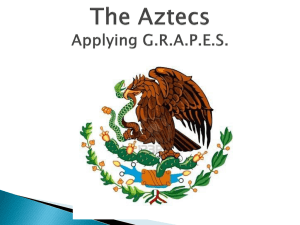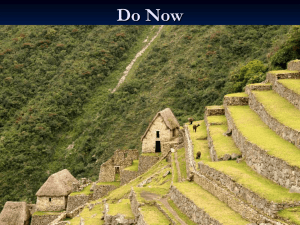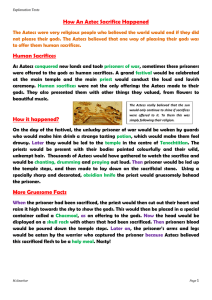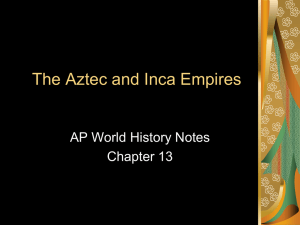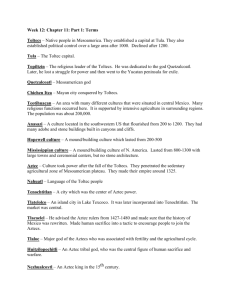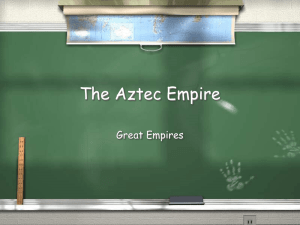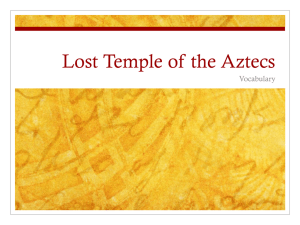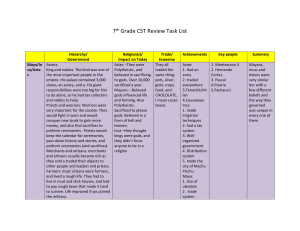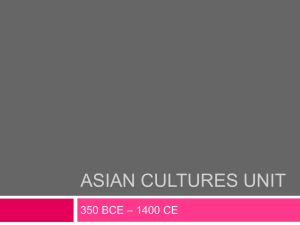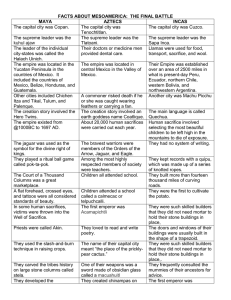File
advertisement
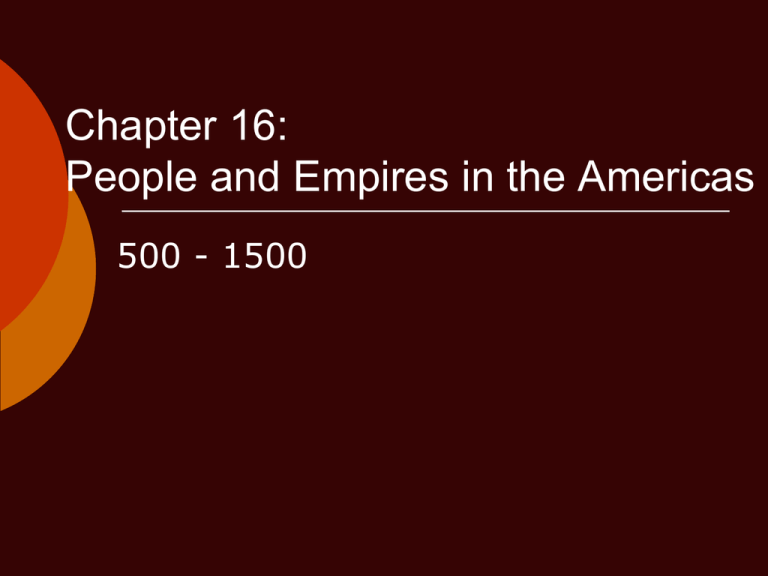
Chapter 16: People and Empires in the Americas 500 - 1500 Chapter 16 Overview Chapter 16: People and Empires in the Americas Section 1: North American Societies Section 2: Maya Kings and Cities Section 3: The Aztecs Control Central America Section 4: The Inca Create a Mountain Empire Section 1: North American Societies No. Amer. natives didn’t create the “grand empires” of regions farther south, but did have rich cultures and great trade amongst groups Culture varied greatly depending upon region (and thus, climate and vegetation), but some similarities: Most had a Great Spirit and worshiped nature spirits Land was sacred—not to be bought/sold Families were basis of social relationships Totems used (symbol for clan/group) No. Amer. Culture Areas c. 1400 Remember, NOBODY has horses yet. Regional Variances: Permanent Houses NW: Fish; wood canoes and houses; potlatch; lived with clans/lg. families SW: Irrigation; adobe; 3 Sisters: corn, beans, squash; Anasazi— Mesa Verde SE: “Five Civilized Tribes”; 3 Sisters; Matriarchal systems Mound Builders: Midwest River Valleys; Lg. burial mounds; evidence of trade with Mesoamerica NE: Woodlands; long houses; political alliances (Iroquois League) Regional Variances: Nomadic Groups Great Plains: tipis (tepee); lg. game, esp. bison; hunter/gatherer; tribes Far North: moved based on season; lg. game + sea life; skins and hides essential Great Basin: tipis, reed houses, or stick lean-tos; lg. game, esp. elk, deer; hunter/gatherer; bands or tribes Trade Connected Groups Trade goods traveled by water, but also land Could cross the mountains Food items, plus prized trade items Pipestone from Minnesota (used for pipes and effigies) found throughout Midwest, Georgia, Rocky Mountains Section 2: Maya Kings and Cities Southern Mexico to Guatemala, Belize, Honduras Built upon Olmec culture Approx. 250 – 900 A.D.: “Classic Period” (height of size and culture) City-states Tikal, Palenque, Chichén Itzá, many others City, religious and trade center Often quarreled/war Trade Common culture, including religion, writing (glyphs), etc. Tikal Temple is on top (pyramid is what a temple stands on) Temple I 160 ft. tall stelae Rather Rigid Social Pyramid Nobles (including Priests, Warriors) “Middle Class” Merchants, skilled artisans, scribes Peasants (farmers…farmers…farmers…) Religion is pivotal to daily life! Many gods, needing almost constant appeasement Some good, some bad—many moody and “humanlike” (think Greek gods) Associated with 4 directions, death, birth, rain, war, foods, etc. Developed several accurate calendars to keep up with when to worship/ sacrifice to which gods Based on astronomical observations Several different calendars… Oh, and that 2012 date? When all 3 calendars hit their end and have to be restarted Worship 101 Sacrifice of food, flowers, incense, people (cenotes), precious jewels, blood Royals offered blood on behalf of the people Called “blood-letting” Lg. ceremonies at Various times of year Associated with ag, solstices/equinoxes * Play ball! Hieroglyphics Over 800 glyphs Many still not deciphered Written on codices (codex) Only 3 survived– Spanish conquerors burned the rest Only “recently” deciphered (in last 40 years) History Mystery Theories abound as to what happened to the Mayas Warfare Disease Deforestation Drought Famine Over-farming Etc. By time Spanish arrived, the Mayans were living in small villages in the forests Section 3: The Aztecs Control Central Mexico (Central) Valley of Mexico Higher elevation But hot, dry Built upon predecessors (who had built upon Olmecs and Zapotecs) Teotihuacán “City of the Gods” Lg. city, apt. living Lg. pyramids, inc. Pyramid of the Sun Estab. trade network, esp. of obsidian Yet another mysterious decline Toltecs Toltecs Ctrl Mexico Pyramids, temples; warriors; lots of sacrifice God: Quetzalcoatl (Feathered Serpent) Was exiled from the land A “naughty god” Rumored to return in the year of 1 Reed (1519) Contributed to at least one ruler being exiled as well When the Aztecs worship me, they sometimes picture me as a pale man with a beard! Aztecs Emerge 1200 A.D. in Valley of Mexico Prophecy told them to find an eagle, on a cactus, with an snake in its mouth In the middle of Lake Texcoco! 1325 Triple Alliance with neighbors Gained control of vast empire Across central Mex. 38 provinces 5 – 15 million people Military tribute (expensive!) Brutal force to make you pay Very Rigid Social Pyramid Ha ha! I love my absolute power! Emperor Nobles: Gov’t officials, Generals, Religious Leaders At the top of this particular class Commoners: Merchants, craftspeople, soldiers, farmers who owned land We HATE working on the chinampas! Enslaved Persons Tenochtitlán: City Planning at its finest! 200,000 – 400,000 population at its height Lg. avenues in town, and then 3 main causeways across the lake to surrounding “suburbs” Religion Rules Daily Life 1,000 (or so) gods! Elaborate public ceremonies That’s a lot to keep happy! Many were gods of previous civilizations, although sometimes they were “different” Offerings by priests Ritual dramas, dances, songs Sun god Huitzilopochtli most important? He needed lots of human blood sacrifices Thousands killed each year on the altar on top of Great Temple Montezuma II Comes to Power Years of high taxes and a growing population of Aztecs made neighbors angry Rebellion and unrest Hee hee Neighbors really irritated with always “contributing sacrifices” (a religious issue) Decreased size of gov’t. Didn’t help Monty saw bad omens in everything Many predictions for demise of empire The year???? 1 Reed……………. Section 4: The Inca Create a Mountain Empire South America in Andes! Cuzco (Peru)—main capital Quito and Santiago—regional capitals Eventually, 2,500 miles long 16 mil. people? Built upon previous cultures: Chavin, Moche, Nazca 1200s in valley by Cuzco Ruler is descended from sun god (Inti) Only 11 lineages could be Inca (emperor) * Worshipped even after death— Is that a problem?! Pachacuti Got empire to largest size c. 1391 – c. 1473 Used diplomacy before conquering Treated new subjects with respect Divided territory into smaller units Governor and local capital “Government architecture” Excellent masons! No mortar needed! Mita required (forced tribute of labor) Population divided into ayllu (extended family groups) SOMEWHAT LIKE SOCIALISM! --a welfare state Daily Life Single language No written language Kept records on quipus Schools taught culture Road system 14,000 mile long network Rope bridges, etc. Guesthouses Pony express runners Incan Religion Fewer gods, but emperor worship, too Not as rigid Reinforced gov’t. Key nature spirits Creator god of Viracocha Sun god Inti Young men/women drafted into religious service (for life) Temple of the Sun in Cuzco Decorated with gold, the “sweat of the sun” Civil War 1520’s, emperor Huayna Capac died Smallpox maybe? It would precede the Spanish conquest Empire split btwn sons Atahualpa and Huascar Got Ecuador Got everything else (4/5th of empire) Civil War Atahualpa won, but war tore apart empire As did small pox! Just in time for some visitors from Spain…
